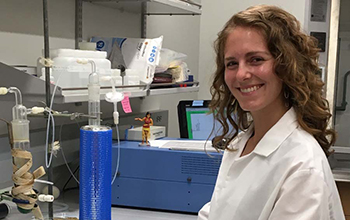搜索结果: 1-15 共查到“海洋生物学 Transport”相关记录23条 . 查询时间(0.234 秒)

Researchers track nutrient transport in the Gulf of Mexico(图)
nutrient transport Gulf Mexico
2020/9/18
The Gulf of Mexico receives considerable levels of nutrients from the rivers that empty into it, especially the Mississippi River, causing the Gulf's northern waters to become overly enriched and more...
Larval Transport and Coastal Upwelling: An Application of HF Radar in Ecological Research
Larval Transport Coastal Upwelling HF Radar Ecological Research
2015/8/10
For many marine fish and invertebrate species, near-surface currents strongly affect the likelihood of surviving as a planktonic larva and arriving at a suitable location, say, a rocky coastline, a ke...
Transport Patterns of Tropical Reef Fish Larvae by Spin-Off Eddies in the Straits of Florida
Tropical Reef Fish Larvae Spin-Off Eddies Straits of Florida
2015/8/10
Tropical reef fishes belong to a broad phylogenetic group and, as a result, exhibit considerable diversity. Their only shared characteristic as an ecological entity is their fate as reef-associated ad...
Larval Transport and Dispersal in the Coastal Ocean and Consequences for Population Connectivity
Larval Transport Dispersal Coastal Ocean Consequences Population Connectivity
2015/7/22
Many marine species have small, pelagic early life stages. For those species, knowledge of population connectivity requires understanding the origin and trajectories of dispersing eggs and larvae amon...
Observing Larval Transport Processes Affecting Population Connectivity:Progress and Challenges
Observing Larval Transport Processes Population Connectivity Progress and Challenges
2015/7/22
Population connectivity is inherently bio-physical: it is determined by physical transport and dispersion, as well as biological processes such as timing of spawning, larval behavior, and mortality. K...
Wave-induced transport and vertical mixing of pelagic eggs and larvae
Wave-induced transport vertical mixing pelagic eggs and larvae
2014/7/10
The transport of pelagic plankton by wind-driven ocean currents and surface gravity waves is investigated for the example of Northeast Arctic cod eggs and larvae on the coast of northern Norway. Previ...
Taxon- and vector-specific variation in species richness and abundance during the transport stage of biological invasions
Taxon- and vector-specific variation species richness abundance the transport stage of biological invasions
2014/4/2
Recent empirical and statistical evidence suggest that propagule pressure (i.e., number of individuals introduced per event, and the number and frequency of events) and colonization pressure (i.e., nu...
Advective transport of diazotrophs and importance of their nitrogen fixation on new and primary production in the western Pacific warm pool
Advective transport diazotrophs importance their nitrogen fixation new primary production in the western Pacific warm pool
2014/4/2
The western Pacific warm pool (WPWP) is a region of low nutrient and chlorophyll concentrations in which new production is generally considered to be supported by upward fluxes of nitrate from the dee...
Upward phosphorus transport by Daphnia diel vertical migration
Daphnia diel vertical migration phosphorus
2014/4/16
In many lakes, zooplankton show a distinct diel vertical migration (DVM) behavior, especially during periods
of stratification. Excretion products of these zooplankton could potentially cause an upwa...
Convectively driven transport in temperate lakes
Convectively driven transport temperate lakes
2014/5/16
Penetrative convection in the surface layer of a midsize temperate lake (5 km2) was investigated in both summer and winter using a conductivity-temperature-depth (CTD) logger mounted on an autonomous ...
Monitoring Drake Passage with elephant seals: Frontal structures and snapshots of transport
Monitoring Drake Passage with elephant seals Frontal structures snapshots of transport
2014/5/16
Conductivity-temperature-pressure satellite relay data loggers (CTD-SRDLs) were attached to southern elephant seals (Mirounga leonina) on the island of South Georgia. During the animals’ migratio...
Relative independence of organic carbon transport and processing in a large temperate river: The Hudson River as both pipe and reactor
Relative independence of organic carbon transport and processing in a large temperate river: The Hudson River as both pipe and reactor
2014/4/18
Bacterial respiration (BR) of organic matter is an important flux in the carbon budgets of large rivers, yet the regulation of BR and the relationship of this respiration to various organic matter sou...
North to Alaska: Evidence for conveyor belt transport of Dungeness crab larvae along the west coast of the United States and Canada
North to Alaska: Evidence conveyor belt transport Dungeness crab larvae west coast United States and Canada
2014/4/22
We propose and evaluate the hypothesis that Dungeness crab (Cancer magister) larvae from the northwestern coast of the United States and Canada can be transported northward to southeastern Alaska. Lar...
Bicarbonate transport and extracellular carbonic anhydrase activity in Bering Sea phytoplankton assemblages: Results from isotope disequilibrium experiments
Bicarbonate transport extracellular carbonic anhydrase activity Bering Sea phytoplankton assemblages isotope disequilibrium experiments
2014/5/5
We used a 14C isotope disequilibrium technique to provide quantitative estimates of both direct HCO3- transport and extracellular CA activity in Bering Sea phytoplankton assemblages. The method reveal...
A note on the potential transport of scalars and organisms by surface waves
potential transport scalars organisms surface waves
2014/5/19
Wave-induced transport that is not directly reflected in Eulerian current measurements, an effect known as Stokes drift, may play a significant role in the transport of organisms and solutes in the ne...

